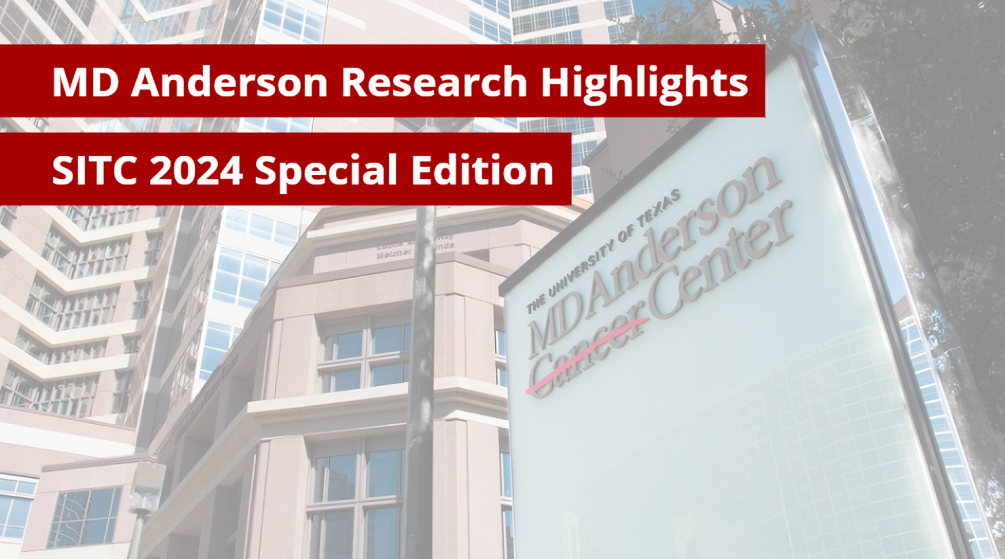
MD Anderson Research Highlights: SITC 2024 Special Edition
Featuring insights into the tumor microenvironment, targets to overcome treatment resistance, and a novel immunotherapy for gastric cancer
The University of Texas MD Anderson Cancer Center’s Research Highlights showcases the latest breakthroughs in cancer care, research and prevention. These advances are made possible through seamless collaboration between MD Anderson’s world-leading clinicians and scientists, bringing discoveries from the lab to the clinic and back.
This special edition features upcoming oral presentations by MD Anderson researchers at the 2024 Society for Immunotherapy of Cancer (SITC) Annual Meeting, providing new insights into the tumor microenvironment and showcasing immunotherapy advances across a variety of cancer types.
Initial data from first-in-human trial demonstrates safety and efficacy of gastric cancer treatment
Some patients with gastric cancer and other solid tumors have abnormal expression of Claudin18.2, a protein found in gastric epithelial cells, making it a potential therapeutic target. In a Phase I trial, Ecaterina Dumbrava and colleagues examined the safety and efficacy of TAC01-CLDN18.2, a new treatment using T cell antigen coupler (TAC) technology to modify a patient’s T cells so they naturally recognize and attack cancer cells.
The trial enrolled heavily pre-treated patients with various cancer types expressing Claudin18.2. In the first two cohorts, no dose-limiting toxicities were reported and disease control was observed in five out of six (83%) initial patients eligible for assessment. These results, including an ongoing confirmed partial response in the first cohort, suggest that TAC01-CLDN18.2 is safe and shows promising clinical activity, leading to further treatment of cohort three. Dumbrava presented the findings Nov. 8.

COVID mRNA vaccines are associated with improved responses to immune checkpoint inhibition
Previous results suggested that COVID-19 mRNA vaccines could enhance immunotherapy and improve survival by increasing PD-L1 expression. Patients with non-small cell lung cancer who were vaccinated within 100 days of their biopsies and treated with immune checkpoint inhibitors lived twice as long as those who were unvaccinated. Patients with metastatic melanoma also had better outcomes, including improved survival and lower risk of disease progression.
Updated results from the study, led by Adam Grippin and Steven Lin demonstrate that COVID-19 mRNA vaccines stimulate secretion of IFN-⍺, a signaling protein that further enhances responses to immune checkpoint inhibitors. Healthy volunteers had a significant increase in plasma IFN-⍺ levels 24 hours after vaccination compared to baseline. These results provide further insights into the underlying mechanisms behind the improved outcomes of vaccinated patients treated with immunotherapy. Grippin presented the results Nov. 8.

Immune checkpoint therapy-related myocarditis (ICT-My), or heart inflammation, is a serious side effect with a reported mortality rate of up to 50%. Neuromuscular immune-related adverse events, such as muscle inflammation (myositis) and myasthenia gravis (MG), which causes muscle weakness, often occur simultaneously with ICT-My and can affect the diaphragm, which plays a major role in breathing. In a new study, Keila Ostos-Mendoza and Nicolas Palaskas and colleagues found that diaphragm failure may be a major driver of ICT-My-related deaths.
In 103 patients who experienced ICT-My, the all-cause mortality rate was 51.4%, with only 30.2% attributed to ICT-My. Deaths related to diaphragm failure and ICT-My occurred more frequently in those with concurrent myositis and/or MG compared to those with isolated ICT-My. The findings suggest that neuromuscular toxicities and diaphragm failure are major contributors to the high mortality rates associated with ICT-My, underscoring a need for better strategies to manage these significant side effects. Ostos-Mendoza presented the data Nov. 8.

AI-assessed tumor microenvironment informs pembrolizumab outcomes in rare tumors
Rare tumors are difficult to study due to a lack of available data and models, but artificial intelligence (AI) can help generate computational models that may predict treatment response. Researchers led by Mohamed Derbala used an AI-powered analysis of biopsies from 84 patients with 10 different histologic subtypes of rare tumors to characterize tumor responses and changes in the tumor microenvironment before and during pembrolizumab treatment.
Changes in tumor infiltrating lymphocyte density and tumor content were significantly associated with progression-free survival and overall survival, especially in subgroups with a higher density of tumor-infiltrating lymphocytes. This AI-powered assessment could potentially inform future personalized treatment strategies and better predict responses in immunotherapy trials for patients with rare tumors. Derbala presented the findings Nov. 8.

Integrated approach characterizes tumor immune microenvironment in pleural mesothelioma
Pleural mesothelioma (PM) – an aggressive cancer in lung tissue associated with asbestos – remains poorly understood with limited treatment options. A deeper understanding of the tumor immune microenvironment (TIME) could help identify potential targets for new therapeutic strategies. Therefore, Katarzyna Tomczak and researchers used multi-omics analysis to examine the TIME in tumor samples from 26 patients with PM who underwent surgical resection.
The study characterized the immune-genomic landscape of the TIME, highlighting the tumor infiltrating lymphocytes and, in some immunosuppressive tumors, the presence of hyperexpanded T cell receptor clones with a potential antitumor response. The findings provide further insights into the TIME of PM and define distinct immune features to inform future clinical trial design. Tomczak presented the findings Nov 8.

Specific tumor-associated macrophage subtype drives immunotherapy treatment resistance
Tumor-associated macrophages (TAMs) are groups of myeloid cells in the tumor microenvironment that can either stimulate or suppress the immune response against tumors. Therefore, understanding different TAM subsets can help in developing effective immunotherapy strategies. In models of melanoma and pancreatic cancer, researchers led by Mehdi Chaib found a subset of TAMs that express the vascular cell adhesion molecule 1 (VCAM-1), a protein that helps leukocytes stick to cells.
This subset was elevated in melanoma tumors after anti-CTLA-4 immunotherapy, and the TAMs caused dysfunctional activation of CD8 T cells and promoted resistance to immunotherapy in vivo, suggesting their potential regulatory role. Further analysis showed that expression of the VCAM-1 gene signature in patients treated with anti-CTLA-4 immunotherapy also was associated with a poor prognosis. The results suggest that VCAM-1 TAMs are negative regulators of T cells associated with anti-CTLA-4 treatment resistance. Chaib presented the findings Nov. 9.

Study identifies iron-rich immune cells as key drivers of tumor growth
Tumor-associated macrophages (TAMs) are common in the tumor microenvironment and can either support or fight cancer growth. Blood vessels that leak red blood cells are a known hallmark of solid tumors, but the influence of red blood cells on TAMs in tumors is not well understood. Therefore, Ian Folkert and colleagues studied how TAMs respond to red blood cells in lab models of sarcoma.
The study uncovered a specific type of iron-rich TAM (iTAM) that helps tumors grow by supporting blood vessel formation and suppressing T cell activity. They also identified a receptor, Ednrb, as a key player in iTAM function. Blocking this receptor, especially when combined with anti-PD1 immunotherapy, reduced tumor growth. The findings suggest that targeting iTAMs and their receptors could offer new treatments for cancers with similar characteristics. Folkert presented the results Nov 9.

Novel combination overcomes treatment resistance in glioblastoma
Glioblastoma is an aggressive type of brain tumor that is often resistant to treatment, partly due to an immunosuppressive tumor microenvironment (TME). The elevated expression of CD47 by glioblastoma cells supports the immunosuppressive TME, marked by a lack of effector T cells and immune cells with impaired phagocytosis – the ability to consume cancer cells.
To overcome this resistance, researchers led by Spencer Lea and Michael Curran examined the use of a STING pathway activator, which reprograms the TME to be proinflammatory, combined with CD47 blockade in treatment-resistant lab models of glioblastoma. STING activation reduced immune suppression and extended T cell-dependent survival. The combination enhanced phagocytosis and further extended survival, highlighting the therapeutic potential of this approach for treatment-resistant glioblastoma. Lea presented the findings Nov. 9.

Machine learning approach highlights treatment effects and biomarkers in lung cancer
Many patients with non-small cell lung cancer (NSCLC) respond differently to various treatments, and understanding the causes behind these differences can help improve outcomes. To that end, Stephanie Schmidt, Tina Cascone, Don Gibbons and colleagues used a machine learning approach to integrate multi-platform data from the ImmunogenomiC PrOfiling of NSCLC Project (ICON) and the NEOSTAR trial.
The researchers generated a novel framework to analyze how different combinations of chemotherapies and immunotherapies affect the immune and microbial landscape of NSCLC and to identify potential response biomarkers. Their model identified 65 treatment-specific impacts and three potential biomarkers of response from over 1,100 measurements in 150 patients.
The model also was able to handle incomplete datasets, maximizing use of available multi-platform data. The researchers currently are validating and refining this integrated approach to provide additional insights for clinical impact. Schmidt presented the data Nov. 9.

About MD Anderson
The University of Texas MD Anderson Cancer Center in Houston ranks as one of the world’s most respected centers focused on cancer patient care, research, education and prevention. The institution’s sole mission is to end cancer for patients and their families around the world, and, in 1971, it became one of the nation’s first National Cancer Institute (NCI)-designated comprehensive cancer centers.
MD Anderson is No. 1 for cancer in U.S. News & World Report’s “Best Hospitals” rankings and has been named one of the nation’s top two hospitals for cancer since the rankings began in 1990. MD Anderson receives a cancer center support grant from the NCI of the National Institutes of Health (P30 CA016672).
More posts featuring MD Anderson Cancer Center on oncodaily.com
Further Reading:
MD Anderson Research Highlights Special Edition: ESMO 2024
MD Anderson Research Highlights for the 2024 World Conference on Lung Cancer
-
Challenging the Status Quo in Colorectal Cancer 2024
December 6-8, 2024
-
ESMO 2024 Congress
September 13-17, 2024
-
ASCO Annual Meeting
May 30 - June 4, 2024
-
Yvonne Award 2024
May 31, 2024
-
OncoThon 2024, Online
Feb. 15, 2024
-
Global Summit on War & Cancer 2023, Online
Dec. 14-16, 2023
